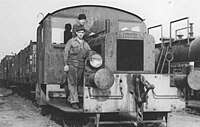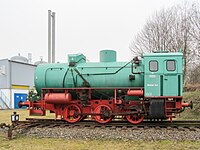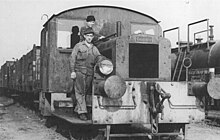Industrial railway of the Eilenburg chemical plant
| Works track of the Eilenburg chemical plant (as of 1993) | |||||||||||||||||||||||||||||||||||||||||||||||||||||||||||||||||||||||||||||||||||||||||||||||||||||||||||||||||||||||||||||
|---|---|---|---|---|---|---|---|---|---|---|---|---|---|---|---|---|---|---|---|---|---|---|---|---|---|---|---|---|---|---|---|---|---|---|---|---|---|---|---|---|---|---|---|---|---|---|---|---|---|---|---|---|---|---|---|---|---|---|---|---|---|---|---|---|---|---|---|---|---|---|---|---|---|---|---|---|---|---|---|---|---|---|---|---|---|---|---|---|---|---|---|---|---|---|---|---|---|---|---|---|---|---|---|---|---|---|---|---|---|---|---|---|---|---|---|---|---|---|---|---|---|---|---|---|---|
| Route length: | 17 km | ||||||||||||||||||||||||||||||||||||||||||||||||||||||||||||||||||||||||||||||||||||||||||||||||||||||||||||||||||||||||||||
| Gauge : | 1435 mm ( standard gauge ) | ||||||||||||||||||||||||||||||||||||||||||||||||||||||||||||||||||||||||||||||||||||||||||||||||||||||||||||||||||||||||||||
| Operator: | Eilenburg chemical plant | ||||||||||||||||||||||||||||||||||||||||||||||||||||||||||||||||||||||||||||||||||||||||||||||||||||||||||||||||||||||||||||
| State: |
|
||||||||||||||||||||||||||||||||||||||||||||||||||||||||||||||||||||||||||||||||||||||||||||||||||||||||||||||||||||||||||||
|
|||||||||||||||||||||||||||||||||||||||||||||||||||||||||||||||||||||||||||||||||||||||||||||||||||||||||||||||||||||||||||||
The industrial railway of the Eilenburg chemical works was a standard gauge industrial and connecting railway of the chemical works in Eilenburg . It was opened on September 23, 1892 as a connecting line to the Deutsche Celluloid-Fabrik and operated until December 31, 1998. The management, which was initially incumbent on the Prussian State Railway , was transferred to the company in 1917, which set up its own railway department. In the course of its existence, the Werkbahn grew with the chemical plant. In 1992 it was 17 kilometers long and had 42 points, including two crossing points. This made it the largest connecting railway in the North Saxon region and, with 106 years of operation, also one of the most traditional.
For internal traffic, the ECW also had a narrow-gauge railway with a gauge of 600 millimeters.
story
The planning for a works railway began just a few years after the opening of the celluloid plant. This also included the connection of two nearby brickworks. The opening date is now September 23, 1892. The high demand for gun cotton caused by the First World War brought about a generous expansion of the company, which was accompanied by an expansion of the connecting railway. Several loading points were created on the company premises. Since the tracks in the central part of the plant (north of Ziegelstraße) partly followed the right-angled road network there, 17 muscle-powered turntables were used to turn the locomotives and wagonsInstalled. After they had been rotated, some of the wagons were pulled down from the turntables into the production buildings using a cable winch.
The increased volume of goods traffic required the establishment of an in-house railway department, to which management was transferred in 1917. For this purpose, two locomotives were initially available, on the one hand a steam storage locomotive , which was used in the explosive parts of the operation of nitrocellulose and celluloid production, and a steam locomotive to transport the goods trains between the depot and the connecting station . With the establishment of the new Decelith product lineStarting in 1936, the tasks of the railway expanded once more, which was also reflected in the expansion of the depot. At the same time, the connection to a brickworks that had existed since the factory railway began operating and had not been required since 1918 was dismantled. The changeover to war production in World War II caused a sharp increase in freight traffic. In order to cope with it, the company bought a more powerful steam storage locomotive in 1944. However, it was too heavy for the manual turntables, so that its usability was limited and it was handed over to the Wolfen film factory around 1957 .
After World War IIboth the continued existence of the chemical plant and the industrial railway were in question. The poor condition of the infrastructure and the lack of skilled workers made it difficult to start operations after the war. After the entire dismantling of the chemical plant was finally averted in 1946, new investments could be made. The industrial railway network grew around the connections of the newly opened peroxide department (1948) and the cellulose acetate department (1963) in the north and the waterworks (1964) in the south of the company premises. At the same time, a new coal bunker was built in Kastanienallee. In return, the middle of the three level crossings over Ziegelstrasse and the feeder tracks to the old heating plant went out of service. Overall, the factory line grew by several kilometers during this time. At the same time, most of the turntables were expanded and replacedSwitches replaced. What remained were two turntables at the water tower and at the company canteen, which have now been converted to electrical operation. In the 1960s, new class V 15 diesel locomotives and steam storage locomotives from RAW Meiningen were purchased. However, the use of diesel locomotives was soon reduced because there was not enough diesel fuel available.
Ziegelstrasse, which was then part of trunk road 87 (F 87), divided the plant into a north and a south part. The shunting over the two level crossings there and the weighing on the weighbridge near the road caused considerable traffic jams. When the factory railway network had reached its greatest expansion with the opening of the container station at the end of the 1970s, there were plans to connect the network with that of the dermatoid factory on the Uferstrasse. As a result, the factory railway traffic could have been partially handled via the connection to the dermatoid. Ultimately, it did not come to fruition. Instead, from the mid-1980s, the dermatoid plant was connected to the EBAWE's works railway as an adjacent connection.
1987 was with a steam storage locomotive of the type FLC 14949 from Raw Meiningenthe last locomotive of the works railway put into operation. It was mainly purchased as a replacement for the diesel locomotives that could only be used to a limited extent. The locomotive with the number 2 is now exhibited as a technical monument on the former factory premises. After reunification and the conversion to the market economy, the individual parts of the company were gradually closed. This also meant that factory rail traffic decreased. In 1994, the dismantling of buildings and facilities that were no longer in use began. The Werkbahn's last orders were for the transport of rubble and scrap trains. On December 16, 1998, traffic ended after 106 years of operation. The official cessation of operations took place on December 31, 1998. By the year 2000, the remaining locomotives and wagons were withdrawn and passed into the inventory of private railway companies or were scrapped. With the exception of the remains of the transfer station, all of the plant's facilities were dismantled and torn down.
vehicles
Standard gauge
In the course of its history, the DCF and ECW works railway carried at least twelve standard-gauge locomotives, seven of which were steam storage locomotives , four small diesel locomotives and one or two steam locomotives . The locomotives 1 (built in 1980), 2 (built in 1987), 3 (built in 1969) and 4 (built in 1965) as well as the converted Gmeinder (built in 1942) have been preserved. The vehicle data is only known from eleven machines.
| No. | design type | Manufacturer | Construction year | Serial number | Operating data | Whereabouts | photo |
|---|---|---|---|---|---|---|---|
| 2 | Cfl | Henschel | 1914 | 13033 | 1956 taken over by the Wolfen film factory, retired in 1981 |
scrapped | |
| ? | Bfl | Hanomag | 1916 | 7803 | newly delivered to the DCF | unknown | |
| 1 | Cfl | Henschel | 1922 | 19232 | taken over by the Wolfen film factory, retired in 1969 |
scrapped | |
| 3 | Vol | Henschel | 1936 | 23150 | newly delivered to the DCF | unknown | |
| 4th | Bdm | Gmeinder | 1942 | 3821 | Newly delivered to the DCF around 1969 conversion to an equipment trolley |
2000 to Museumseisenbahn Finsterwalde eV |

|
| ? | Cfl | ME | 1944 | 4694 | Newly delivered to DCF in 1957, handed over to Filmfabrik Wolfen, where it was retired in the 1970s |
scrapped | |
| 5 | Cfl | LKM | 1961 | 146663 | delivered new to the ECW around 1992 retired |
scrapped in 1995 | |
| 4th | Bdh | LKM | 1965 | 261456 | delivered new to the ECW around 1994 retired |
1994 to IG Nordsächsisch-Mitteldeutsche Eisenbahnfreunde, Merseburg | |
| 3 | Cfl | LKM | 1969 | 219182 | delivered new to the ECW around 1994 retired |
1994 to Friends of the Torgau Railway | |
| 1 | That is | LEW | 1980 | 16964 | delivered new to the ECW around 1998 retired |
1999 to MaLoWa Bahnwerkstatt GmbH | |
| 2 | Cfl | RAW Meiningen | 1987 | 03155 | delivered new to the ECW around 1998 retired |
2000 to Friends of the Torgau Railway Set up in 2002 as a technical monument on the former factory premises |

|
Narrow gauge
Little is known about the narrow-gauge network of the ECW works railway. So there is no clarity as to what extent it was and how long it was operated. Two locomotives from Orenstein & Koppel are known , which were delivered to the DCF in 1915, which may mark the year that operations began. Remnants of the narrow-gauge railway are preserved on the site of the successor company Polyplast Compound Werk (as of 2020). It is the oldest part of the chemical plant north of today's street Am alten Celluloidwerk .
| design type | Manufacturer | Construction year | Serial number | Operating data | Whereabouts |
|---|---|---|---|---|---|
| Bn2t | OK | 1915 | 7337 | newly delivered to the DCF | unknown |
| Bn2t | OK | 1915 | 7338 | newly delivered to the DCF | unknown |
Operating points
- Transfer station ⊙
The DCF (or ECW) connecting line met the Pretzsch – Eilenburg line between the Eilenburg and Eilenburg Ost stations . At the level of the connection, the Aw signal box was built until 1927 when the Wurzen – Eilenburg railway branched off from the Halle – Cottbus railway line running parallel . At this time, at the latest, the DCF transfer station was built. It consisted of a four- track harp (tracks A1 to A4) and two pull-out tracks running to the east. Tracks A1 to A4 had a length between 215 and 327 meters. From the northern of the four tracks branched off the eastern of the two rail lines leading to the plant (track 5). It was built in the 1960s as part of the construction of the new power station (south of Ziegelstrasse) and the coal unloading point. From the main track of the transfer station there was both the connection to the Pretzsch – Eilenburg line in the direction of Eilenburg station and, in its extension, the western track leading to the plant (track 2), which ran in an arch west of the waterworks. The Aw signal box, which was responsible for the operations at the transfer station, was located in a wedge between the line and track 2 of the plant.
The facilities of the transfer station are the last remaining remnants of the ECW works railway. The two lines leading to the plant were completely dismantled by 2008. The connection to the main track has now also been expanded, separating the tracks from the network. The Aw signal box is still in operation today. A level crossing over the main line in Kastanienallee was closed around 2008 after the barrier had only been opened when needed.
- Coal unloading point ⊙
Originally, the coal wagons were unloaded south of Ziegelstrasse in the so-called tilting tower. There the wagons were fixed and rotated until the coal fell out of them. From there the coal was transported with a conveyor system over Ziegelstrasse to the boiler house. Since it was not possible to reactivate the old coal conveyor system after 1945, a third track was built across the F 87, on which the coal was delivered to the boiler house until the 1950s. With the commissioning of the new medium-pressure power plant on the factory site south of the F 87 in 1957, a new method of supplying coal had to be found.
In 1964, a new unloading point for coal block trains made up of self-unloading wagons was built in Kastanienallee at the level of the former Serum plant in the course of works track 5 (eastern track from the transfer station to the plant) . The unloaded raw lignite fell into a trench bunker with sloping impact walls. With the shutdown of the power plant in the 1990s, the coal bunker was no longer needed. The rails on the unloading bridge were removed around 2007, and the entire facility was dismantled a year later. The area has been renatured. A part of the area has been designated as a dog meadow by the city.
- Depot ⊙
The depot was located immediately south of Ziegelstrasse at the level of the eastern level crossing. It was set up presumably in connection with the company's takeover of operations management in 1917. The growing tasks of the industrial railway made it necessary to expand capacities in the mid-1930s. Since then, the factory shop has had four stalls. In addition to the locomotive shed, the depot had three tracks (tracks 4 to 6) and two butt tracks (6a and 6b).
After the factory railway had ceased operations in 1998, individual locomotives and wagons were parked in the depot until at least 2000, including factory locomotive 2, which today is a technical monument that commemorates the history of the factory railway. After the depot was closed, the level crossings over the B 87 were dismantled. In 2007, only the gatekeeper house and a stump of the barrier remained of the eastern level crossing . At that time the depot had already been completely dismantled. The remains of the barrier system disappeared around the year 2008. Today nothing can be seen of the entire station system. The site is fallow and may be revitalized as a retail location.
- Container terminal ⊙
After the ISO container gradually gained acceptance in international goods traffic, a container terminal was built in the ECW in the second half of the 1970s. It was located in the northeast of the factory premises at the level of the Steinaue road and consisted of a loading and a bypass track. There was no road connection. The containers were loaded with a mobile slewing crane 404 , the transport of the individual containers was carried out by a tug of the type Progress ZT 300 with a corresponding trailer. There was also a floodlight system. The factory railway network had reached its greatest extent with the container station. The planned extension to the connecting line of the nearby dermatoid plant was not implemented.
The container terminal was demolished in 1999 as one of the first facilities on the works railway. The new Ernst-Mey-Straße was built here as a bypass road to relieve the Eilenburg-Ost district . Today nothing reminds of this system.
staff
During the GDR era, the factory railway was manned in a continuous three-shift system . The crew of one shift consisted of a shift supervisor, two locomotive drivers, two shunting ladders and a gatekeeper. In addition, there were also the connecting railway conductor, the foreman, two locomotive fitters and an approximately five-man strong track-laying brigade working day shifts.
Cultural monument
With the gatekeeper house at the western level crossing over Ziegelstrasse to the left of the administration building, the Werkbahn also had a listed building. It was a two-story plastered building with an almost closed all-round window front on the upper floor, a sturdy sill and a pyramid roof with a sphere at the end. The house dates from around 1915 and was therefore built at the same time as the neighboring administration building. Despite being a listed building , it was demolished in 2007. The eastern pillar of the gateway is still there.
Web links
- Werkbahn of the Eilenburger chemical plant on Bahn-Express - magazine for Werkbahnfreunde
Individual evidence
-
↑ Steffen Reichert: It was the tenth anniversary of the cessation of operations of the ECW factory railway in the official journal for the city of Eilenburg, January 30, 2009, pages 7 and 8
Note: According to Reichert (2009), the track length of 17 kilometers was used by a weed control train in 1992 measured. This may have included unused but still existing track sections. Elsewhere in the text there is talk of more than 10 kilometers. - ↑ a b c d e Steffen Reichert: It was the tenth anniversary of the cessation of operations of the ECW factory railway in the official journal for the city of Eilenburg, January 30, 2009, pages 7 and 8
- ↑ Meinigen type FLC steam storage locomotive. Retrieved November 11, 2020 .
- ↑ a b Eilenburger Chemiewerk AG (ECW) in Bahn-Express - Magazine for Werkbahnfreunde (accessed on November 10, 2020)
- ↑ Portrait of the Henschel 23150 (built in 1936) on the rangierdiesel.de page (accessed on November 10, 2020)
- ↑ Portrait of Gmeinder 3821 (Bj. 1942) on the page rangierdiesel.de (accessed on November 10, 2020)
- ↑ Portrait of LKM 261456 (built in 1965) on the rangierdiesel.de page (accessed on November 10, 2020)
- ↑ Track plan of the Eilenburg station and the connecting line of the ECW (around 1960s) on sachsenschiene.net (accessed on November 9, 2020)










